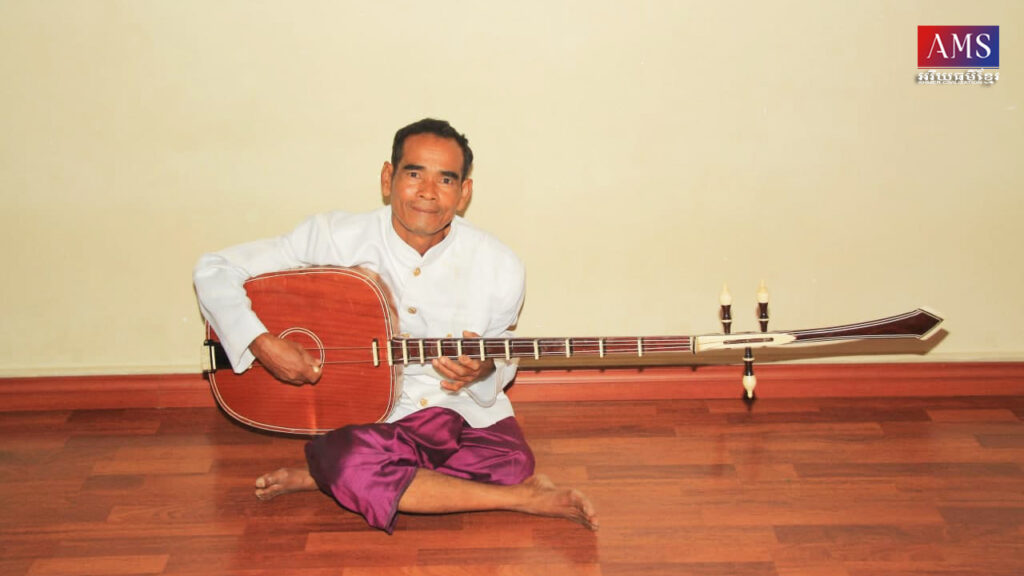
ចាប៉ីដងវែង ឬចាប៉ីវែង មានស្នូកឬប្រអប់សូររាងដូចស្លឹកពោធិ ឬផ្លែម្នាស់ធ្វើពីរាំង ខ្នុរ ឬបេងពីម្ខាងទៅម្ខាងប្រវែង ៣០.៥ ស.ម. និងពីលើមកក្រោម ប្រវែង ៤០.៥ ស.ម.។ ចាប៉ីដងវែងមានដងធ្វើពីក្រសាំងប្រវែង ៩១ ស.ម. សន្ទះធ្វើពីក្ទម្ពឬឈើស្រាលដូចជាស្រល់ ឬរលួស គីង្គក់ធ្វើពីធ្នុង និងខ្ទង់ធ្វើពីឆ្អឹង។ មានពាក្យខ្មែរពីបុរាណកាលពោលថា៖ «ស្នូករាំង ដងក្រសាំង សន្ទះក្ទម្ព គីង្គក់ធ្នុង ខ្ទង់ឆ្អឹង» ខ្សែពីរ ឬត្រួតពីរ (គឺបួន) ធ្វើពីលោហធាតុ ឬនីឡុង។
ខ្មែរយើងប្រើចាប៉ីដងវែងនៅក្នុងវង់តន្ត្រីអារក្សនិងអាពាហ៍ពិពាហ៍បុរាណ។ ជាពិសេសទៅទៀត គេប្រើចាប៉ីដងវែងសម្រាប់សម្តែងទោល ឬច្រៀងឆ្លងឆ្លើយគ្នាដែលយើងហៅថាច្រៀងចាប៉ី។ គេសម្តែងចាប៉ីដងវែង នៅក្នុងពិធីបុណ្យទានផ្សេងៗ ដូចជាបុណ្យជាតិ បុណ្យសាស នា មហោស្រព និងព្រឹត្តិការណ៍ផ្សេងៗ។
លោកព្រឹទ្ធាចារ្យច្រៀងចាប៉ី ប្រាជ្ញ ឈួន បានមានប្រសាសន៍ថា៖ «ខ្ញុំចូលចិត្តទៅស្តាប់ច្រៀងចាប៉ី ព្រោះខ្ញុំជក់ចិត្តនឹងវា ហើយខ្ញុំក៏មានបំណងចង់ថែរក្សាសម្បត្តិវប្បធម៌នេះដែរ ដែលឥឡូវសឹងតែបាត់បង់ទៅហើយ។ នាពេលបច្ចុប្បន្ននេះ គេមិនសូវជួលសិល្បៈ ច្រៀងចាប៉ីឱ្យទៅលេងនៅក្នុងពិធីបុណ្យប្រពៃណី ដូចពីដើមឡើយ ដែលខ្មែរយើងមានចំណាប់អារម្មណ៍នឹងការគាំទ្រច្រើន»។

យ៉ាងណាមិញនាពេលបច្ចុប្បន្ន យើងឃើញមានការទទួលស្គាល់ និងគាំទ្រពីមជ្ឈដ្ឋាននានា ដែលជាមោទនភាពរបស់ជាតិយើង។ សេចក្តីសង្ឃឹមរបស់យើងទៅលើជីវិត សេចក្តីសង្ឃឹម របស់យើងទៅលើជីវិតរបស់ចាប៉ីដងវែងនិងច្រៀងចាប៉ី គឺស្ថិតនៅលើការបន្តជ្រោមជ្រែងនិងលើកស្ទួយសិល្បៈតន្ត្រីនេះ ពីសំណាក់ទស្សនិកជន និងប្រជាជនខ្មែរ។ នៅឆ្នាំ ២០១៦ ចាប៉ីដងវែង និងច្រៀងចាប៉ី ត្រូវបានគេចុះក្នុងបញ្ជីបេតិកភណ្ឌអរូបីនៃមនុស្សជាតិ នៃអង្គការយូណេស្កូ ដែលជាការពង្រឹងស្មារតីនិងជំរុញលើកទឹកចិត្តដល់សិល្បករច្រៀងចាប៉ី ក្នុងការបង្កើនការខិតខំប្រឹងប្រែងសម្តែង បង្រៀន និងបណ្តុះបណ្តាលសិស្សជំនាន់ក្រោយឱ្យចេះ យល់ដឹង ស្រឡាញ់ និងបន្តលើកស្ទួយសិល្បៈវប្បធម៌ដ៏មានតម្លៃនេះបន្តទៅមុខទៀត។
ទោះបីជាសិល្បៈច្រៀងចាប៉ីបាននិងមានដំណើរការល្អប្រសើរជាងមុនក្តី ក៏យើងនៅតែត្រូវការ ការជួយជ្រោមជ្រែងទំនុកបំរុងឱ្យមានកម្មវិធី និងទីកន្លែងសម្រាប់សម្តែងនិងបណ្តុះបណ្តាលល្អត្រឹមត្រូវ ដើម្បីផ្ទេរចំណេះដឹងពីឪពុកទៅកូន ឬពីគ្រូទៅសិស្ស ដែលជាបញ្ហាមួយសព្វថ្ងៃនេះ។ នៅក្នុងបរិបទសកលភាវូបនីយកម្ម ច្រៀងចាប៉ីប្រឈម នឹងបញ្ហាមួយចំនួន ដូចជាការប្រកួតប្រជែង នឹងទម្រង់សិល្បៈកែកម្សាន្តបច្ចេកវិទ្យាទំនើបថ្មី សម្បូណ៌បែបនិងងាយស្រួល បញ្ហាសេដ្ឋកិច្ច កង្វះខាតកម្មវិធីសិល្បៈសាធារណៈនិងកម្មវិធីសិល្បៈសិក្សាស្តួចស្តើង។

——————————————————-
Long-necked Lute and Epic Singing
Chapey Dang Veng, also Chapey Veng, is a long-necked lute. Its resonator (side to side is 30.5 centimeters and top to bottom is 40.5 centimeters) is made of a selected wood called Raing, Khnoar, or Beng in a shape of the banyan leaf or pineapple. The finger-board (91 centimeters long) is made of Krasaing; the resonator-box is covered with a piece of thin wood called Khtum, the bridges are made of Thnung, and the frets are made of bone. In the middle of each of the twelve frets, a hole is drilled through which a string is put to hold them together to protect them from dropping or losing. There is a Khmer saying describing this instrument:
Snauk raing (Resonator-box of Raing)
Dang krasaing (Finger-board of krasaing)
Santeah Khtum (Resonator-box cover of Khtum)
Kingkuok thnung (Bridge of thnung)
Khtung chha-oeung (Frets of bone)
The two strings or two courses of two strings are made of gut or nylon and tuned a fourth apart with the following scales: low string FGABCDEFGABCD and high string BCDEFGABCDEFG.
The long-necked lute is used in the old instrumentation of the worship of the spirit and wedding ensembles. However, it is most popularly known and used in the Khmer epic singing in which the vocalist accompanies himself on the instrument.
Khmer Chrieng Chapey or epic singing is often performed on national holidays, at village festivals, and important events at temples throughout the country. It is also performed on various official ceremonial occasions as tradition calls for or on request by special interest groups. It is a vulgarization of the story. Stories and themes are selected by the singers or sponsors appropriate to the organized events. For instance, if it is a religious, in this case, Buddhist ceremony, it would be appropriate to select one of the Buddhist Jataka stories. If it is for a sponsor’s anniversary, it would be appropriate to sing a biography of the sponsor. If it is a political campaign, it would be appropriate to select a political theme or praise of a Candidate’s success stories or achievements. If it is a celebration of a New Year, the singer would render on the delight of welcoming the New Year and the joy and high spirit associated with the celebration.
Prach Chhuon, a master of Chrieng Chapey, once said: “I still love to go to Chrieng Chapey because I am addicted to it, and I wish to preserve this heritage because now it has almost been vanished. Nowadays, epic singing is not hired often enough to perform at traditional ceremonies, unlike in the past when there were a lot of interests among our compatriots.” At the present, recognition of Chrieng Chapey is increasing, which brings a sense of pride to the Cambodian nation. Our hope for Chrieng Chapey to survive will rest with the continued support from the Cambodian public.
In 2016, the Chapey dang Veng and Chrieng Chapey were enlisted on the list of the UNESCO Oral and Intangible Heritage of Humanity, which boosts the morale and encourages Khmer epic singing artists to increase their efforts in performing and teaching the next generation of young Khmer to lean and carry on this invaluable tradition to the future. Now, we have a chance to refresh our skills in Chrieng Chapey because television channels in Phnom Penh have hired the artists to play for them. Although Chrieng Chapey has recently been revitalized, there are still many needs such as supports and proper places for training and performance. The transmission and continuity from fathers to children and from masters to pupils are one of the problems we still face today.
The survival of Chrieng Chapey depends on various factors, including competition from contemporary forms of entertainment within the context of globalization, economic difficulties, and insufficient emphasis on public programming and school curricula among others.
អត្ថបទដោយ៖ បណ្ឌិត សំ សំអាង






